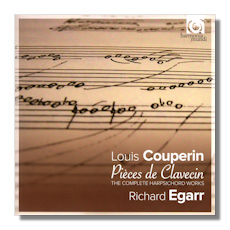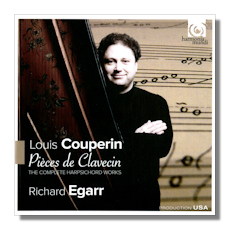
The Internet's Premier Classical Music Source
Related Links
- Latest Reviews
- More Reviews
-
By Composer
-
Collections
DVD & Blu-ray
Books
Concert Reviews
Articles/Interviews
Software
Audio
Search Amazon
Recommended Links
Site News
 CD Review
CD Review
Louis Couperin

Complete Pièces de Clavecin
- Suite in G minor
- Suite in G Major
- Suite in E minor
- Suite in D minor
- Suite in D Major
- Suite in C minor
- Suite in C Major
- Suite in A minor
- Suite in A Major
- Pavane in F Sharp minor
- Suite in F Major
- Suite in B minor
- Les Carillons de Paris
Richard Egarr, harpsichord
Harmonia Mundi HMU907511.14 4CDs
This excellent survey of all of Louis Couperin's Pièces de Clavecin by Richard Egarr contrasts with that by Christoph Rousset on Aparté AP006 in that it contains – over four CDs – of virtually all the composer's extant work for harpsichord… three additional movements in a privately-owned manuscript (by Guy Oldham) are not included here. The two main sources on which both Rousset and Egarr have compiled their performances are the "Bauyn" manuscript, which was copied some time after 1676 and contains 133 individual pieces; and the "Parville" manuscript, which contains 50 pieces also in Bauyn and five further works not in Bauyn. Accordingly, Eggar's four CDs (some five hours of music) actually has 130 individual movements: the manuscripts additionally contain a number of pieces for viols and organ (and other carillons) which are omitted here.
Egarr plays copies of two of the most important types of harpsichord available during the first half of the seventeenth century, when Louis Couperin was working: a Parisian and Ruckers; both were made by Joel Katzman. Significantly, each uses a real quill. This imparts a gentler, more subtle yet no less impactful sound to the performances. It also seems to command our attention more fully – not because the sound is quieter overall, but because the range of harmonics is more focused. The sound really does seem more authentic. The attack is more accommodating; the experience less mechanical; successive notes somehow sound more relaxed, particularly in the faster pieces; and there is a greater equilibrium throughout. This, of course, is ideally Suite to the special, strongly delicate and restrained sound world which these unspectacular yet highly expressive pieces of Couperin need. Egarr ended up (he experimented) tuning around a'=398.
This is, then, music that must be concentrated on. Every note, every contour, every nuanced harmony (Couperin was as interested in harmonies as textures) counts. There is, frankly, little to be gained by expecting the pieces to "wash over you" and make some sort of composite impact. Each bar, each phrase, each carefully-constructed unit of texture or developmental/melodic meaning has to be appreciated in its own right, as a valid statement of its own. It's true that, once the portion of the music to which you choose to listen, has quietly left you, so powerful is the music's sense of cohesion and direction that it will stay with you. But almost less as sound as abstract musical construction.

This sense of the abstract, of the essence of Couperin's music is what distinguishes Egarr's playing from that of Rousset. Each approach is wholly valid. Rousset marginally gives a priority to the sound; Egarr to the inner import of the build. But it must be said that neither omits anything which we need in order to understand and enjoy the music. For Rousset could not arrive at his highly persuasive performance without a profound grasp of how the Suites were composed and work constructed as they do. Egarr's is far from a "mathematically informed performance". Though his sense of precision and the need for exactitude is exemplary… listen to his control of (and hence greater expressivity in) the tempi in the gavotte of the C Major suite [CD.1 tr.20]. It's a marvelous balance between only slightly subdued excitement – as the direction which Egarr unfailingly brings out in all of these pieces becomes obvious – and immense awareness of how the steps in that direction are taken. Significantly, then, Egarr makes the case for the special, the gem-like, status of this small body of Baroque instrumental music.
Egarr is quite happy for our listening practice to reflect the way that Couperin expected his pieces to be experienced: at will, in a variety of orders… he even suggests shuffling on an MP3 player. Of course they are grouped by Suite and tend to follow the general progression from Prelude to Chaconne, Gigue or Sarabande via Allemande, Gavotte and Courante etc. But there is as much variation in Egarr's order as there happens to be in the lengths of the Suites. He does perform the Suites in the order of the scale – CD 1 beginning with the C's, CD 4 ends with the B's. (Les Carillons de Paris actually concludes the whole set). But the moods and atmospheres evoked by every one of Couperin's pieces are so different and full of such contrast that they're each taken on their own merit.
And those merits are many: Couperin delighted in imitation, in the unexpected, in the slightly-altered norm, in unique rhythms, surprising harmonies, polyphony and – above all – highly distilled, concentrated, tautly-focused self-contained statements. Egarr is so well able to bring out every ounce of musicality in this respect. He's not at pains to "sell" the uniqueness of Couperin's invention. It recommends itself. It almost needs no advocate. In the notes which Egarr publishes with the CD likens the particularities of Couperin's creativity with these genres to that of Purcell. But Couperin's world is less pressing, he seems less eager to capture the listener's attention, less self-conscious than Purcell. It's this calm yet striking essence of Couperin's achievement that Egarr communicates so well in this highly collectible set (there's no other full set in the current catalog).
The recordings are clean, close and eminently easy to listen to. Made in two locations, they comprise a total of five hours; and come with a nicely-produced booklet with background and commentary in Egarr's own personal style. There's no reason other than cost why you shouldn't repeatedly enjoy both this and Rousset's performances. Each player makes an irrefutable case for the greatness of Couperin, and the special place in the repertoire which these works occupy. Recommended without hesitation.
Copyright © 2011, Mark Sealey.





















